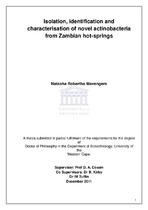| dc.description.abstract | Actinomycetes are ubiquitous in many environments such as soil, activated sludge and water.Besides the genus Streptomyces, which has been extensively exploited, members of other genera including Micromonospora have been shown to be a promising source of novel secondary metabolites and enzymes.The biocatalytic conversion of 5-monosubstituted hydantoin derivatives to optically pure amino acids involves two reaction steps. The first step, catalysed by a hydantoinase, yields an N-carbamylamino acid intermediate, which is subsequently broken down by an Ncarbamoylase to the amino acid. This process has been successfully applied in industry for the production of optically pure amino acids which are used in the synthesis of pharmaceuticals,insecticides, hormones, and food additives. The need for novel hydantoinases to hydrolyse a wider variety of substrates is increasing.
This thesis describes the search for a novel hydantoinase from environmental isolates obtained from two Zambian hot-springs. The aim of this study was to isolate, characterise and screen novel actinobacteria for industrially relevant enzymes including hydantoinases. Fifty one actinobacteria were isolated. Isolates were characterized by a polyphasic approach using standard methods, combining phylogenetic analysis of the 16S rRNA gene, chemotaxonomic and phenotypic characterization. Results revealed that these sites were dominated by actinobacteria belonging to the family Micromonosporaceae, and a potentially novel
Verrucosispora species was identified. Screening the isolate identified a Streptomyces species which has hydantoinase, carbamoylase, amidase and nitrilase activities.The Streptomyces sp. hydantionase was cloned and functionally expressed in E.coli. The recombinant enzyme showed 49 % similarity to a crystallised hydantoinase from a Bacillus species. Homology modelling revealed that the enzyme had the TIM barrel topology which is characteristic of hydantoinases. Amino acid residues predicted to be involved in the catalytic
activity as well as substrate orientation were identified. The partially purified hydantoinase was characterised and showed optimally activity at 45 °C and pH 8.
This study revealed that hot springs may represent a previously unexplored source of novel actinobacterial diversity. However, it also revealed that novel secondary metabolites are not only limited to novel organisms but that some of the answers for the challenges we face today maybe found in organisms we have already encountered and characterised. | en_US |

